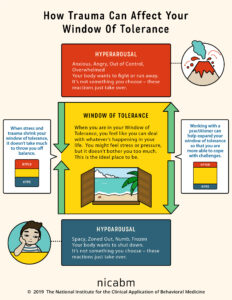Experiencing complex trauma can overwhelm your
window of tolerance repetitively and across time.
-Brain Jo, PhD
 Learning how to regulate your brain and body is the key to staying within one’s window of tolerance. When an individual experiences childhood trauma, as most adopted children do, it significantly impacts how wide their window of tolerance is. Another factor effecting your child’s window of tolerance is how well they have resolved this trauma. Let’s delve into each of these factors to truly understand how your child’s past may still be influencing how they manage their emotions and natural stressors that come about in life. In other words, if you can understand how your child’s window of tolerance has been shaped by their trauma, then you can meet them with empathy and understanding. To help your children increase their tolerance for distress, after you put on your compassion hat, you can then help them learn techniques to make positive change. That window of tolerance can absolutely be widened with skills and practice.
Learning how to regulate your brain and body is the key to staying within one’s window of tolerance. When an individual experiences childhood trauma, as most adopted children do, it significantly impacts how wide their window of tolerance is. Another factor effecting your child’s window of tolerance is how well they have resolved this trauma. Let’s delve into each of these factors to truly understand how your child’s past may still be influencing how they manage their emotions and natural stressors that come about in life. In other words, if you can understand how your child’s window of tolerance has been shaped by their trauma, then you can meet them with empathy and understanding. To help your children increase their tolerance for distress, after you put on your compassion hat, you can then help them learn techniques to make positive change. That window of tolerance can absolutely be widened with skills and practice.
Safety
Remember that newborn from the previous article who was hungry and crying? And then remember how their caregiver picked them up and fed them? Well, that repeated action of meeting the baby’s basic needs is the foundation of learning how to tolerate icky feelings. It’s the backbone of having a thriving and wide window of tolerance. Now think about that infant again and this time they are crying but their *mother cannot figure out what is wrong with them. So eventually the mother just ends up holding the baby and rocking in the rocking chair. This is the beginning of teaching that baby that their needs are important, they are safe, and they are not alone. When these ordinary and intuitive interactions between baby and mother occur, the infant is free to concentrate on soaking up everything about their world. Their brain grows exponentially as it should at this early age. Because this infant’s basic needs are consistently met, they can securely attach to their mother and learn, learn, learn. This is the backbone of healthy development and leads to a wide window of tolerance.
Co-regulation
Now imagine that baby and mother again. The mother was never taught how to calm herself; regulate her body and brain, thus leaving her with a narrow window of tolerance. Now imagine that baby is crying again and this time, like before, the tears are not because she is hungry, tired, or wet. The mother, because she has a limited tolerance for distress, becomes upset as she is unable to soothe her baby. Instead of picking her up and rocking her, she angrily puts her back alone in the crib and leaves the room. The baby is missing the opportunity to learn that human touch and rocking are soothing. She is afraid as she is alone: scared as she is a helpless baby who cannot do anything for herself. Now imagine this scenario occurring hundreds of times. This leads to early, complex trauma. The baby has lost the valuable and crucial opportunity to learn how to calm her nervous system: this is what co-regulation is all about. So now this little baby will grow up just like her mom with a narrow and limited window of tolerance.
 Unresolved Trauma
Unresolved Trauma
The hopeful thing about trauma is that it can be healed and resolved. It takes a lot of work and creativity learning how to decrease the negative effects upon one’s life. You may have noticed how your child’s early trauma lowers their ability to experience hard feelings. You may observe that they feel scared at times when there is actually no visible threat around. Perhaps they tend to make mountains out of molehills. It seems to take the smallest issues to push them over the edge. Or maybe they seem to be spacing out too much and are just not present. Remember the dissociation we mentioned in the previous piece?Basically their past trauma is living in and interfering in the present. Their triggers are plentiful and lower their window’s of tolerance over and over. That lack of safety your child felt when they were young keeps popping up. This is how unresolved, complex trauma harms us when we do not go to play therapy or do EMDR or practice yoga to heal our trauma.
There’s Always Hope
Good news: there are plenty of ways to widen your window of tolerance and your child’s. Research shows us that we can teach our brains to change and learn to better tolerate distress, hard feelings, unplanned changes, and so forth. It may be necessary for a professional to get involved, but there are simple concrete things you can do to help your child widen their windows. Keep reading this Newsletter to gain simple, real-life methods to increase that window of tolerance.
*For the sake of consistency, I will be using the word mother to represent caregiver.*





